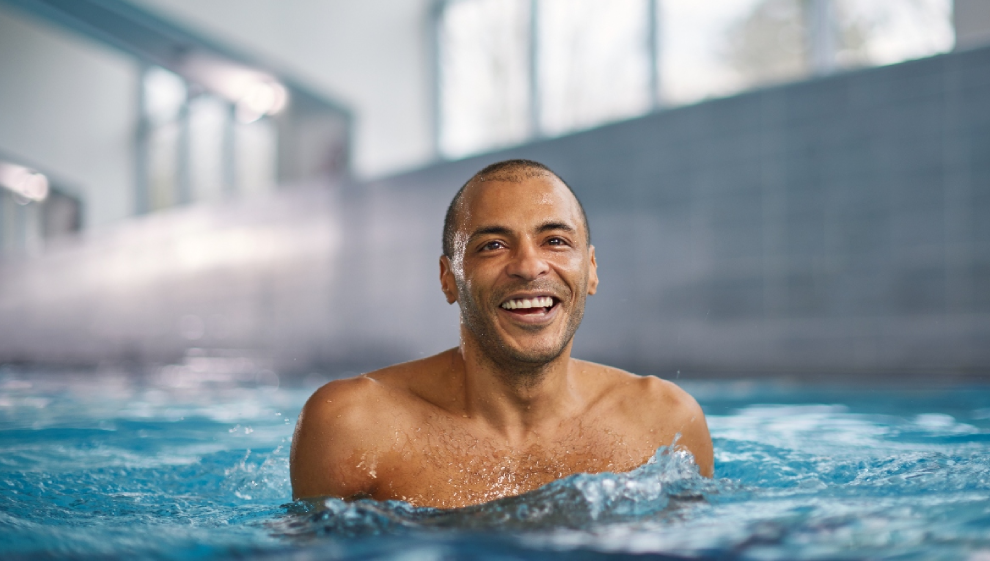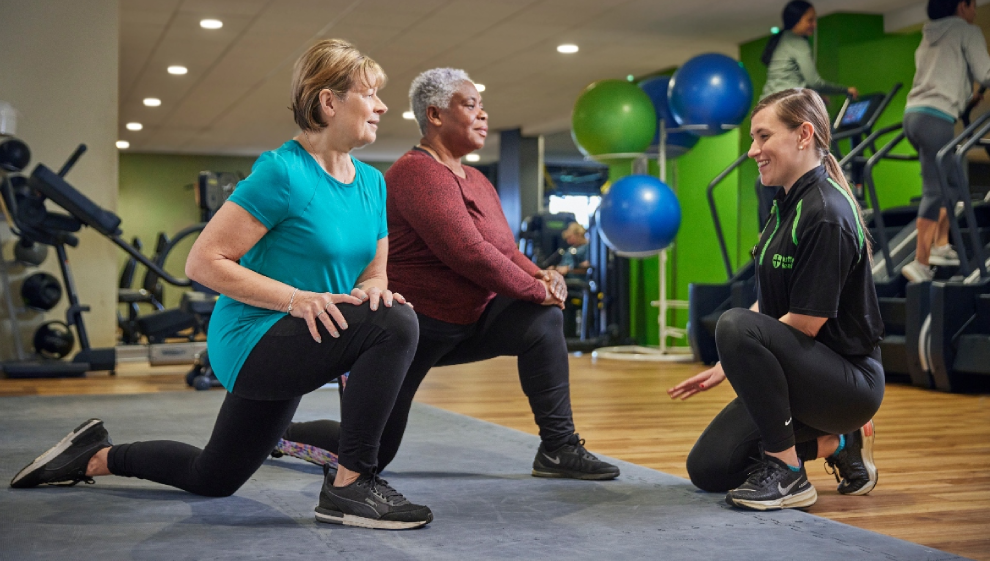What is physical activity? Learn more about moderate and vigorous intensity exercise
- Overview
The NHS guidelines for physical activity

The NHS advise that all adults should aim to do “at least 150 minutes of moderate intensity activity a week or 75 minutes of vigorous intensity activity a week”.
This guidance also states we should perform “strengthening activities that work all the major muscle groups including the legs, hips, back, abdomen, chest, shoulders and arms” at least twice a week.
For maximum benefit, we recommend spreading this active time out evenly throughout the week. You’ll lower your risk of injury and reap the rewards of building a small amount of movement and exercise into your day-to-day routine.
Does the advice change as we age?
Yes, but only slightly. Government guidelines suggest that for older adults, it is beneficial to add in activities and exercises that will help improve our balance. This will help reduce our chance of frailty and our risk of falls.
Joint pain and discomfort as we age is not inevitable.
We will experience unavoidable muscle loss (sarcopenia), but if we continue to do physical activity and train with resistance, we can help slow this process down.
Aiming to be physically active in some capacity every day becomes more important as we age. For adults over the age of 65, the NHS recommend “activities that improve strength, balance and flexibility at least 2 days a week” and “at least 150 minutes of moderate intensity activity a week or 75 minutes of vigorous intensity activity a week”.
If you haven’t done moderate intensity physical activity in a while, it’s always worth seeing a GP before you start again. This can help reduce your risk of injury and build a routine that works for you and your body.
What is physical activity?
Guidance on activity can be confusing. Many of us know that we need to be physically active and move more, but we’re not sure what counts or how to do it.
Below, we explain what’s meant by ‘moderate’, and ‘vigorous’ in relation to physical activity and how to recognise each phase. Because we’re all different, what one person finds easy may be more challenging for another. It’s important to recognise what physical activities work for you and to build on your own ability and capacity over time.
We’ve included some example activities to match each definition and help you on the road to meeting your movement target goal for the week.
Moderate intensity physical activity
What is it?
Moderate intensity is defined as physical activity (or exercise) that keeps your heart rate at 50 to 70% of its age-predicted maximum capacity.
How do I know I’m doing it?
A rough gauge of whether you’ve moved into the “moderate” bracket is whether or not you’re able to talk for a long period without struggling. Seeing if you can comfortably sing a song whilst exercising is another fun way of gauging intensity.
Because we know it’s not practical for everyone to burst into song at the gym, paying attention to your breathing and your perspiration (sweat) levels are two other reliable indicators.
What are some example activities?
- Brisk walking
- Water aerobics
- Dance
- Tennis
- Biking slower than 10 miles per hour
- Swimming
- Active travel
Vigorous-intensity exercise
What is it?
Vigorous intensity is defined as physical activity that keeps your heart rate at 70 to 85% of its age-predicted maximum capacity. These activities are more intense and will speed up the rate at which you sweat and get out of breath.
How do I know I’m doing it?
Vigorous physical activity will increase your heart rate and speed up your breathing pattern. This will make holding a conversation more difficult.
If you’re having trouble talking without pausing for breath, you’re probably moving at a vigorous intensity. You’ll also notice that your muscles are working harder and that you’re perspiring (sweating) at a higher rate.
What are some example activities?
- Hiking uphill
- Running
- Swimming laps
- Cycling 10 miles per hour or faster
- Skipping
- Playing sport
- Taking part in aerobic exercise classes
- Using cardiovascular gym equipment
Is walking physical activity?
Absolutely, but it’s all about intensity and what that means to you and your body.
The important word to keep in mind is ‘brisk’. What this means will differ from person to person. The NHS defines it as “about 3 miles per hour” and feeling like “anything more than a stroll”.
Again, try using the singing method to test whether you’re hitting this pace or not. If you can still talk but can’t sing the words to a song, you’re probably there.
This speed won’t be applicable to everyone and doesn’t mean that if you’re walking slower, you’re not doing something that’s benefiting your body. We’re all different and move at different speeds depending on various factors. Find a pace and distance that’s safe and comfortable and work on increasing it over time.
Does being active at work count?
Whilst there may be sudden intense periods where you’re more active than usual, work-related movement tends to be drawn out throughout the day. Whilst it’s typically not intense enough to provide significant cardiovascular benefits, this doesn’t mean that it’s not beneficial.
If you have an active job where you’re logging lots of steps and coming home tired, chances are you’re meeting the threshold for having performed some amount of moderate-intensity physical activity that day.
It’s important to remember the difference between moderate-intensity physical activity and vigorous intensity physical activity and how these different movement styles impact the body. Doing a lot of steps at work or being moderately active at a low intensity on the job cannot be seen as a substitute for purposeful, moderate intensity physical activity that gets our heart rate up.
You might be doing more than you think
Lots of us are on the move throughout the day which goes a long way to keeping our body fit and healthy. What we might not realise is that a lot of this movement qualifies as physical activity without our knowledge.
If you’re curious about activities of everyday living and how they relate to ‘physical activity’, click here to find out more.
What counts is relative to your current activity level
It’s important to remember that what counts as physical activity for you is all relative to your current activity level.
If you currently live a sedentary lifestyle where you don’t get much movement in at all, anything you do is going to boost your active time. If you’re already quite physically active, you’re likely going to have to do something a bit more intense to stimulate your body.
For example, if you’re an active individual, throwing your washing in the dryer probably won’t work up much of a sweat. For someone else, walking to the dryer and bending down to place each garment in one by one might feel a bit more challenging.
How to get started
If you’ve never done physical activity (or exercised) before…
This will all depend on your physical ability, your condition, and your age. The golden rule of starting small and building up over time is a good place to start if you’ve never really done much moderate intensity or higher physical activity before.
- If you’re resistance training, choose a weight that’s comfortable and that you can easily handle. This could be tins of beans at home or a light weight in the gym. Avoid the temptation to test yourself right away – good form is far more important than weight
- If you’re walking, get comfortable on your feet and find a pace that allows you to maintain a conversation. Build a routine around a distance that works for you before building things up
- If you’re running, use walking as your guide. As the saying goes, don’t run before you can walk. Couch to 5k is a great place to start as it’s built around the “run/walk” training philosophy
- If you’re swimming, get comfortable in the water and take note of how your joints and muscles feel. Aim to build up to a length over time by increasing distance as you get more and more comfortable
- If you’re playing sport, make sure you’re playing with others who are around your ability level. Pushing yourself in an environment that’s too advanced could knock your confidence and cause injury.
If you’re concerned about your age…

The best thing about physical activity is that it’s for everyone. As we age, we may not be able to match the intensity we put in when we were younger, but we can adapt and adjust our routine to benefit our body as it changes.
The good news is that there’s nothing stopping us from starting again. The same rules of starting small and building up over time apply to everyone.
If you’ve maintained physical activity over the years, chances are you understand what your body can and cannot do. If you’re getting back into it or want to start moving a bit more, it’s important you get some professional advice, especially if you suffer from joint pain, mobility problems, or severe flexibility issues.
If you have a pre-existing condition…
If you’re concerned about a condition or ailment, it’s important you don’t dive right into moderate and vigorous physical activity. This is especially important if you have a cardiac condition or you’ve recently undergone surgery.
If you have a pre-existing condition, always seek professional advice before starting a new movement or exercise routine. Having a word with a GP or clinician can be the start of a beneficial conversation around building a routine that works for you and your unique condition.
If joint pain is an issue…
Joint pain describes discomfort, soreness, or inflammation in any part of a joint. It can get worse over time and will have a big impact on your ability to be physically active and move about in a pain-free manner.
Whether you’re thinking about physical activity or you’ve tried and found yourself in considerable pain, our free to access Joint Pain Programme can help.
The 6-month programme begins with 12 weeks of lifestyle advice and exercise sessions led by a Rehabilitation Specialist. The best part? It really works. Since we started the programme, we’ve helped tens of thousands of people improve their mobility, flexibility, and move towards a future where pain doesn’t dictate what they do.
- Interested? Click here to find out more
Last updated Monday 15 April 2024
First published on Monday 15 April 2024

